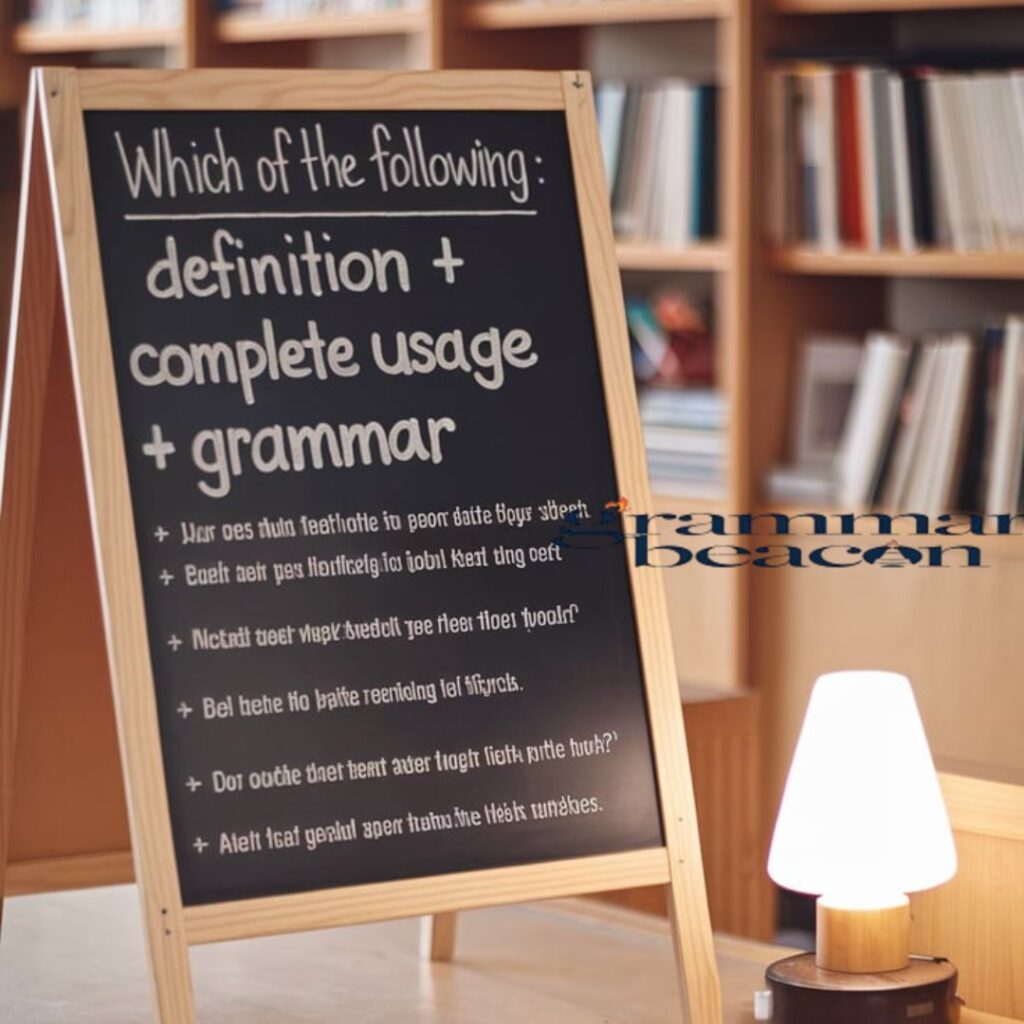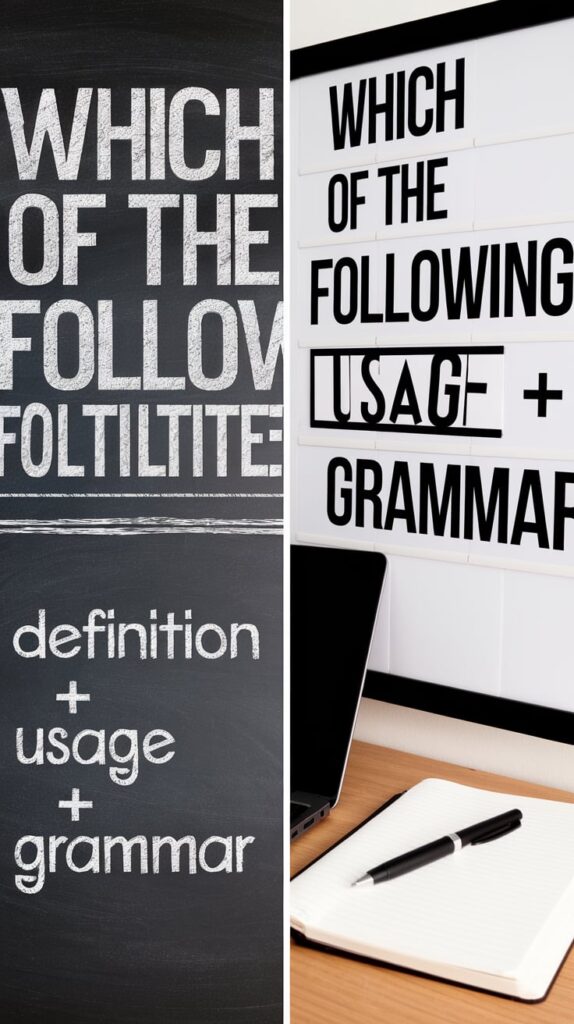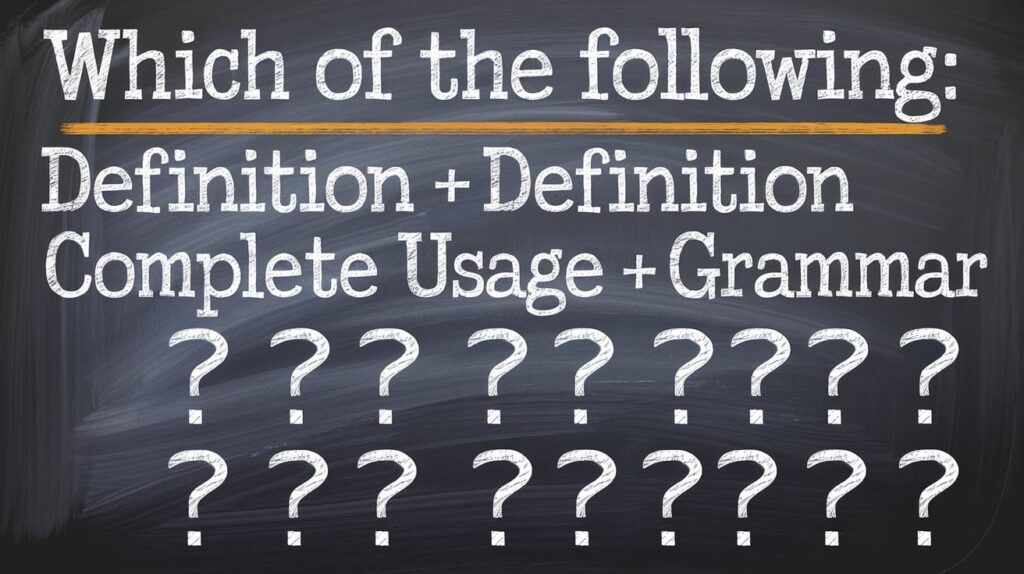Struggling to frame clear multiple-choice questions or surveys? The phrase “Which of the following” is your secret weapon! Whether in tests, quizzes, surveys, or casual conversations, this simple phrase guides your audience to make precise choices without confusion.
Master its definition, correct grammar, real-life examples, and expert tips to craft questions that are clear, professional, and engaging every time. Unlock the power of this phrase and make your communication sharper and more effective!
Definition

The phrase serves as an introductory clause that presents a list of options from which a respondent must choose. This phrase is structured to simplify decision-making by providing clear alternatives, allowing for straightforward responses.
Key Characteristics
Introduces Choices: This phrase typically indicates that a specific list of options will follow, making it easier for the audience to select the correct answer or preferred choice.
Context-Dependent: The phrase’s meaning can shift based on where and how it is used, showcasing its versatility across different contexts.
Structured Format: This phrase often precedes a list of options, thereby enhancing clarity and facilitating comprehension.
Importance of Definition
Understanding what the phrase means is crucial, as it sets the stage for the types of questions asked in various formats, from academic assessments to casual conversations.
This understanding also aids in crafting more engaging and clear questions, reducing misunderstandings and encouraging precise responses.
Complete Usage
The phrase is widely utilized in various contexts, including educational assessments, surveys, quizzes, and everyday conversations. Below are some detailed scenarios illustrating its application.
In Educational Assessments
In educational settings, especially in quizzes and tests, this phrase is often employed to gauge students’ knowledge on specific subjects.
- Example: “Which of the following is the capital of France?”
- Options: A) Berlin B) Madrid C) Paris D) Rome
- Purpose: This question aims to assess students’ understanding of geography and key facts. The structured format allows students to focus on their knowledge and make a clear selection.
Using “which of the following” not only tests knowledge but also encourages critical thinking, as students must evaluate their options carefully.
like to read : 15 Other Ways to Say “My Work Here Is Done” – Grammar Beacon
Multiple-Choice Format
This phrase is particularly useful in multiple-choice questions, where clarity is paramount. Instructors can use it to present several plausible answers, increasing the question’s complexity while ensuring students know exactly what is being asked.
- Example: “Which of the following gases is most abundant in the Earth’s atmosphere?”
- Options: A) Oxygen B) Nitrogen C) Carbon Dioxide D) Argon
- Purpose: This tests students’ understanding of atmospheric science, requiring them to differentiate between various gases based on their abundance.
In Surveys

To collect specific information from respondents about their preferences, opinions, or experiences. This phrase simplifies the response process, enabling participants to select from clear options.
- Example: “Which of the following features do you find most useful in our product?”
- Options: A) User Interface B) Speed C) Customization D) Support
- Purpose: This structure collects actionable feedback from customers, facilitating product improvement.
Surveys benefit from this phrase by guiding respondents toward clear and concise choices, leading to more accurate data collection. The options presented can often be tailored to address particular areas of interest for the surveyors, ensuring that the feedback gathered is relevant and actionable.
In Quizzes
Quizzes, whether in academic settings or casual contexts, often employ “which of the following” to present options that participants must consider.
- Example: “Which of the following events occurred first?”
- Options: A) The signing of the Magna Carta B) The American Revolution C) The French Revolution
- Purpose: This type of question evaluates the quiz-taker’s knowledge of historical chronology or sequence.
Using the sentence ensures that the question remains straightforward while allowing for effective assessment. This method can be particularly engaging in interactive quizzes, where participants enjoy the challenge of recalling information accurately.
Lists of Choices
This phrase is effective for presenting multiple options clearly and systematically. For example:
Science Context: “Which of the following elements is a noble gas?”
- Options: A) Oxygen B) Helium C) Nitrogen D) Neon
History Context: “Which of the following events led to the Great Depression?”
- Options: A) Stock Market Crash B) World War I C) The Dust Bowl
Product Features: “Which of the following improvements would you like to see in our app?”
- Options: A) Faster Load Times B) New Features C) Improved Interface
This structure not only makes the questions clearer but also reduces the cognitive load on respondents, allowing them to focus on making informed decisions based on the options provided.
Importance of Clarity
Employing the phrase enhances clarity in questions, providing a structured approach that enables respondents to focus on the options presented.
This reduces ambiguity and fosters more accurate responses. Clarity in communication is particularly important in educational and professional contexts, where misunderstandings can lead to incorrect conclusions or assessments.
Grammar Rules
Understanding the grammar rules associated with “which of the following” is crucial for effective communication. This section will cover key grammatical aspects, including subject-verb agreement, punctuation, and common mistakes related to this phrase.
Subject-Verb Agreement
Ensuring proper subject-verb agreement is vital. The verb must align with the noun that follows the phrase.
Using “Is”
When the noun that follows is singular, use “is.”
- Example: “Which of the following is a reptile?”
- Explanation: In this case, “reptile” is singular, so “is” is appropriate. This correct usage helps maintain clarity and accuracy in the question.
Using “Are”
Conversely, when the noun is plural, “are” should be used.
- Example: “Which of the following are mammals?”
- Explanation: Here, “mammals” is plural, thus requiring “are.” This adherence to grammatical rules enhances the professionalism of your communication.
Punctuation

Generally, a colon should precede the list that follows this phrase.
- Example: “Which of the following are colors: red, blue, or green?”
- Explanation: The colon indicates that a list will follow, clarifying the question structure.
Is it Correct to Use “Which of the Followings”?
The phrase is grammatically incorrect. The word “following” should remain singular, regardless of the number of options presented.
- Incorrect: “Which of the followings is correct?”
- Correct: “Which of the following is correct?”
This distinction is essential for maintaining grammatical accuracy and should be remembered to avoid common pitfalls in writing and speaking.
Common Questions
To clarify further, let’s address some common examples and the correct forms:
- Which of the following is a winter sport?
- Which of the following are summer activities?
- Which of the following hobbies do you like the most?
These examples illustrate how the verb aligns correctly with the subject following the phrase. Understanding these distinctions will aid in crafting more accurate and engaging questions.
Should I Use “Is” or “Are” with “Which of the Following”?
Determining whether to use “is” or “are” depends on the context of the question:
Singular Context: When referring to one option or a singular noun.
- “Which of the following is a fruit?” (Correct)
Plural Context: When referring to multiple options or a plural noun.
- “Which of the following are vegetables?” (Correct)
This distinction is essential for grammatical precision. Misuse of “is” and “are” can lead to confusion and misinterpretation, affecting the clarity of your communication.
Usage in Various Contexts
In Science Tests
In science tests can effectively assess students’ understanding of complex concepts. For instance:
- Example: “Which of the following elements is a noble gas?”
- Options: A) Oxygen B) Helium C) Carbon D) Nitrogen
- Purpose: This question tests knowledge of the periodic table and the properties of elements.
Science tests often include challenging questions that require students to apply their knowledge to differentiate between closely related concepts.
In History Quizzes
History quizzes frequently employ this phrase to examine knowledge of significant events and timelines.
- Example: “Which of the following events occurred first?”
- Options: A) The signing of the Magna Carta B) The American Revolution C) The French Revolution
- Purpose: This question evaluates the quiz-taker’s understanding of historical chronology.
In this context not only tests factual knowledge but also engages students in critical thinking about historical sequences.
like to read : “WOAT” Definition, Origin, and Usage – Grammar Beacon
In Surveys
Surveys utilize this phrase to help respondents articulate their preferences effectively, providing structured feedback.
- Example: “Which of the following features do you find most useful in our product?”
- Options: A) User Interface B) Speed C) Customer Support
- Purpose: This structure helps companies gather valuable insights from their audience.
Surveys benefit
from this structured approach, enabling the collection of clear, actionable data that can inform future decisions and improvements.
In Casual Conversations

Beyond formal contexts, can also be used in casual conversations to clarify options.
- Example: “Which of the following movies do you want to watch tonight?”
- Options: A) Action B) Comedy C) Horror
- Purpose: This informal setting allows friends to engage in decision-making collaboratively.
This flexibility showcases the phrase’s utility across various scenarios, making it a versatile component of everyday language.
Synonyms
It’s beneficial to know some synonyms that can add variety to your communication.
- “Which among these”: This phrase can serve as an alternative when listing options, often used in more formal contexts.
- “Choose from these”: A simpler way to phrase the question when the audience is familiar with the topic.
- “Select from the following”: This version provides clarity and maintains a formal tone.
Using synonyms judiciously can enhance your writing and speaking by preventing redundancy and keeping your audience engaged.
Tips for Proper Usage
To maximize the effectiveness, consider the following tips:
Keep It Simple: Aim for clarity. Avoid overly complicated structures that might confuse the audience.
Be Specific: Ensure that the options provided are directly related to the question, minimizing ambiguity.
Test Your Audience: Before finalizing your questions, consider your audience’s background knowledge to ensure the options are appropriate.
Practice Grammar: Regularly review grammar rules associated with subject-verb agreement and proper usage to enhance your communication skills.
By applying these tips, you can improve your use of the phrase,” making your communication more effective and engaging.
Conclusion
In summary, the phrase “which of the following” is an invaluable tool in communication, allowing for clear choices across various contexts, including education, surveys, and casual conversations.
Understanding its definition, usage, and grammar rules can significantly enhance your ability to communicate effectively. Employing this phrase correctly not only aids in accurate assessments but also encourages meaningful dialogue, enabling you to convey your ideas more effectively.
Whether you’re crafting questions for a test, designing a survey, or engaging in casual conversation, the proper use of the phrase will undoubtedly enrich your communication skills and lead to more successful outcomes.
FAQs
What does “Which of the following” mean?
It introduces a list of options and asks the audience to select the correct or preferred one. Perfect for quizzes, surveys, or discussions.
Is “Which of the followings” correct?
No. Always use “Which of the following” “following” stays singular, no matter how many options there are.
Should I use “is” or “are” after it?
Use “is” for singular nouns and “are” for plural nouns. Example: “Which of the following is a fruit?” vs “Which of the following are vegetables?”
Can it be used in casual conversation?
Absolutely! Use it to decide movies, meals, or activities: “Which of the following movies do you want to watch tonight?”
What are some alternatives to this phrase?
“Which among these,” “Choose from these,” or “Select from the following” can make your questions more varied and professional.
How do I make my multiple-choice questions clearer?
Keep the options directly related to the question, avoid ambiguity, and always use proper grammar. This ensures accurate and easy responses.

Steve Rogars is an experienced blogger and language enthusiast at Grammar Beacon. With a passion for clear communication and a keen eye for detail, he shares insights on grammar, writing tips, and language trends. Steve’s engaging style makes learning enjoyable, helping readers enhance their writing skills. When he’s not crafting posts, he enjoys reading, exploring new cultures, and inspiring others to appreciate the beauty of language.







